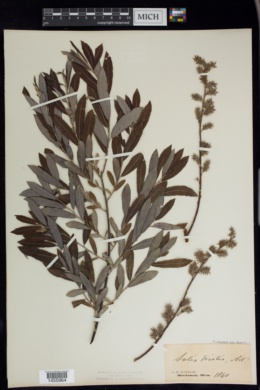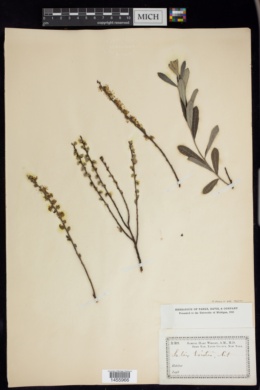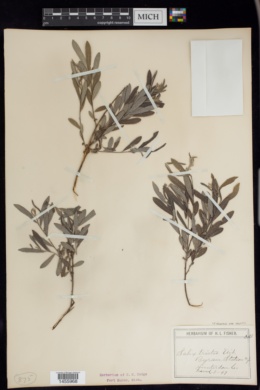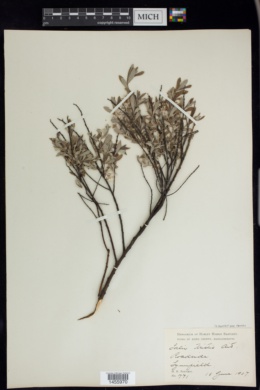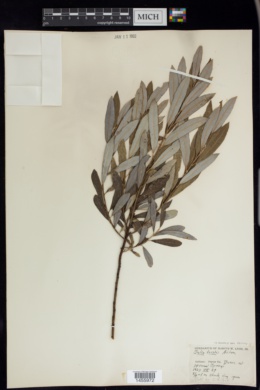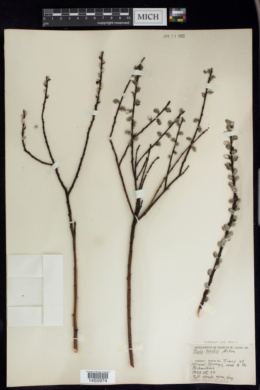Salix humilis var. tristis
|
|
|
|
Family: Salicaceae
Prairie Willow
|
Low to mid shrubs, 0.3-1 m. Stems decumbent; branches tomentose, peeled wood smooth or striate, striae sparse, to 2 mm; branchlets yellow-brown. Leaves: stipules absent or rudimentary on late ones; petiole 0.5-3(-6) mm, velvety or villous adaxially; largest medial blade narrowly oblong, narrowly elliptic, oblanceolate, or obovate, (13-)20-50(-70) × 3-13 mm, 2.3-9 times as long as wide, margins strongly revolute, abaxial surface hairs gray throughout, adaxial slightly glossy, moderately densely tomentose; proximal blade margins entire. Catkins: staminate 6.5-13.5 × 5-10 mm, flowering branchlet 0-1 mm; pistillate 11-17.5 × 5.5-12 mm, flowering branchlet 0-1.5 mm; floral bract 0.8-1.4 mm. Staminate flowers: filaments glabrous or hairy basally. Pistillate flowers: ovary pyriform; ovules 6 per ovary; stigmas 0.2-0.24-0.32 mm. Capsules 5-9 mm. Flowering early Mar-late May. Moist limestone and serpentine barrens, open heath balds, open pine woods, moist prairies, swampy areas in open deciduous woods, stream banks; 60-1600 m; Ark., Conn., Del., D.C., Ga., Ill., Ind., Kans., Ky., La., Maine, Md., Mass., Mich., Minn., Miss., Mo., N.H., N.J., N.Y., N.C., N.Dak., Ohio, Okla., Pa., R.I., S.C., Tenn., Va., W.Va., Wis. Hybrids: Although variety tristis is reported to hybridize with Salix eriocephala, S. humilis var. humilis, and S. petiolaris (G. W. Argus 1986), hybrids have not been confirmed.
Shrub 0.5 - 1 m tall Leaves: alternate, on yellowish to pinkish, 2 - 3 mm long, hairy leafstalks, dark green above, paler with a waxy coating (glaucous) beneath, yellowish to pinkish on midrib, 2 - 5 cm long, 0.5 - 1 cm wide, narrowly lance-shaped to linear-oblong with a tapering base and pointed tip, slightly revolute (rolled downward along the margins), sometimes hairy above, and gray-woolly beneath. Young leaves are brownish red, thin, translucent, and minutely hairy. Flowers: either male or female, borne on separate trees (dioecious) in stalkless, oval to egg-shaped, hairy catkins. Female catkin green to purplish with blackish scales, 1 - 2 cm long. Stigmas red. Ovary densely hairy. Male catkin whitish with blackish scales, 0.5 - 1.2 cm long. Stamens two, with red anthers (turning yellow). Fruit: a capsule, in elongated clusters, short-stalked, brownish, flask-shaped, and hairy. Seeds have long, white, silky hairs attached. Twigs: slender, brown-tinged, and hairy. Buds: reddish brown to brown, egg-shaped, flattened, pointed, and slightly hairy. Similar species: In the Chicago Region, Salix humilis var. tristis differs from most other willows by having hairy leaf undersides and downward-rolled (revolute) leaf margins that are not distinctly toothed. Variety humilis is similar to variety tristis but on a larger scale, with leaves that do not remain hairy. Salix pedicellaris, a small shrub that grows in bogs and fens, has leaves similar to both S. humilis varieties; however, the leaves of S. pedicellaris are finely net-veined on both sides and have parallel primary lateral veins. Flowering: April to early May, before the leaves Habitat and ecology: Occasionally found in the Chicago Region, in prairies and other dry open places. Occurence in the Chicago region: native Notes: Planted as an ornamental. Etymology: Salix is the Latin word for willow. Humilis means low-growing. Tristis means dull. Author: The Morton Arboretum From Flora of Indiana (1940) by Charles C. Deam This is a small shrubby willow with a habit and habitat similar to the preceding species [Salix humilis]. It also has nearly the same distribution but is much less frequent and, in fact, as I understand the plant, it would be restricted to our western prairie area. Since almost all of my specimens were named by C. R. Ball, I am using his determinations to show the distribution in Indiana. After studying my specimens carefully and noting the habitats from which they came, I have come to the conclusion that this species is merely an ecological form of the preceding species. Griggs and Schaffner both regard it as a variety of the preceding. This and the preceding species are most common in White County and I have seen them growing side by side in a strictly prairie habitat, which fact might be used to support their separation, but I am not able to find any constant structural difference. …… Indiana Coefficient of Conservatism: C = 5 Wetland Indicator Status: FACW |




